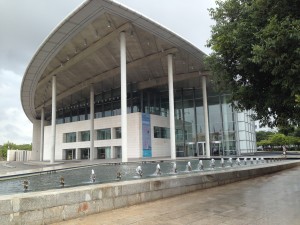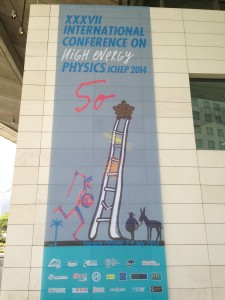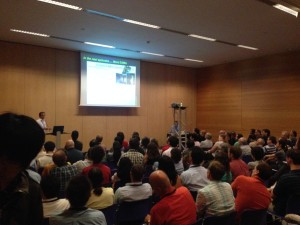The shops and restaurants surrounding the Palacio de Congressos in Valencia were swamped by droves of physicists when lunch broke on the first day of the International Conference of High Energy Physics or ICHEP 2014 (July 2-9). Academic types from all over the world could be seen on sidewalks in different huddled groups trying to puzzle out the “menu del dia” before cramming into restaurants to eat quickly and get back to the exciting early afternoon presentation sessions.

Nearly 1000 of the world´s top particle physicists and cosmologists gathered in Valencia this year for a bi-annual meeting of the minds to discuss the deepest questions regarding the nature of reality. The ICHEP is the defining conference for the field of high energy physics and attracts the top researchers and scientists from around the world – researchers who are working on the human race´s most advanced experiments and theories. These are the people who are responsible for re-writing science textbooks and are the mysterious yet authoritative “they” we refer to when we say things like “You know, they think that the universe will keep expanding forever”.
 As you might imagine, the content of the conference was anything but “light” (pun intended). One of the main topics was the Brout-Englert-Higgs boson and the presentation and discussion of the first sets of data which included a talk by Nobel Laureate François Englert, co-author of the BEH Mechanism. The second experimental run with the Higgs boson will begin in 2015 when the LHC (Large Hadron Collider) at CERN is put back on-line after a two year upgrade process involving (among many other things) the decoupling 27 km of magnets. The final result will be a much higher energy limit to search for more particles (that´s right, “they” think there are a whole bunch more new particles just around the corner).
As you might imagine, the content of the conference was anything but “light” (pun intended). One of the main topics was the Brout-Englert-Higgs boson and the presentation and discussion of the first sets of data which included a talk by Nobel Laureate François Englert, co-author of the BEH Mechanism. The second experimental run with the Higgs boson will begin in 2015 when the LHC (Large Hadron Collider) at CERN is put back on-line after a two year upgrade process involving (among many other things) the decoupling 27 km of magnets. The final result will be a much higher energy limit to search for more particles (that´s right, “they” think there are a whole bunch more new particles just around the corner). 
But beyond the Higgs boson, the main theme dominating everybody´s presentation seems to be the search for Dark Matter and Dark Energy. The current view is that Dark Matter makes up about 80% of the matter in the Universe. The only problem is, we can´t see it. It is neutral and doesn’t interact with regular matter. There could be some in your coffee right now and you would never know it! Dark Energy is even more mysterious and thought to be the driving force behind the expanding universe. In fact, the expansion of the universe appears to be accelerating, which goes against all our logic and models of the cosmos…therefore it must be due to some kind of unknown dark energy. So almost every major experiment at the sub-atomic level, as well as with telescope surveys at the cosmological level are all trying to find evidence of Dark Matter (DM). They (there is that “they” again) believe that DM exists mainly from the observed gravitational behavior of galaxies…namely that the stars closest to the galactic center and the stars at the outer limits are orbiting at rates that only make sense if there is 80% more matter in the universe than we can see.
So whether speaking of detection tanks in abandoned mines in Canada filled with liquid argon, or the Dark Energy Survey which uses a 570 Megapixel camera attached to a telescope with a 4m lens to peer deep into the cosmos with unprecedented resolution, or even the incredible work done at the subatomic level through experiments at the LHC and other high-energy colliders, everyone is looking for DM – principally in the form of WIMPs (Weakly Interacting Massive Particles).
And yet no one has found a trace, at least not directly.
But that doesn´t mean it is time for discouragement. It took 30 years to find the neutrino and they have only been looking hard for Dark Matter for 20. Perhaps even more interesting is that the weakly interacting Higgs Boson (that´s why it was so hard to find it in the first place) just may be the particle that eventually helps us find DM because it just may be the only one that interacts directly with it.

Another major topic at the conference was the recent results from BICEP2, a terrestrial telescope at the south pole, which earlier this year seemed to detect and confirm the existence of gravitational waves predicted by expansion theory. Expansion theory basically says that the universe expanded SUPER FAST at first (in the first billionth of a second) and then slowed down considerably afterwards. Gravitational waves would have been a kind of bi-product of that expansion. The issue at the moment is that not all of the BICEP2 data has been analyzed, and even more importantly, there hasn´t been confirmation from a second source (an absolute necessity in science). Still, the current data looks very promising. Alan Ruth, the father of expansion theory was in attendance at the conference and spoke after the BICEP2 results were revealed saying that “even if the results are not confirmed; it does not mean that the theory is not correct.” There are various possible versions of expansion theory and what is hoped is that the data will help to confirm the correct theoretical version.
The first 3 days of the conference consisted mainly of researchers presenting their most recent data or search results – sometimes so recent that one speaker would comment on his own data saying: “new data was presented this morning by ´so-and-so´ which updates what we are looking at here”. There were also scientists presenting new theories or methods for finding Dark Matter, as well as sessions discussing the computing and data analysis at CERN. There were so many sessions (400 talks all in all) stretching over many specialized fields that they had to be run parallel so that attendees would sometimes have to choose which talks to attend at different times. Later in the conference, plenary sessions (47) were held to recap all the major points, announcements and implications in each field. Modern physics is so complex that most particle physicists are highly specialized by necessity. So the plenary sessions are a golden opportunity for many researchers to get up-to-date on what is happening in other areas of the field. Finally, scientists at ICHEP 2014 discussed the future of the LHC and plans for the next generation of colliders in Asia and America, as well as a massive 100km collider at CERN – a project with planning and implementation to last over the next 50 years.
 The ICHEP is organized on a biannual basis by the C11 Section (Particles and Fields) of the International Union for Pure and Applied Physics (IUPAP), and is the world’s most relevant meeting in the field of Elementary Particle Physics. The previous editions have been held at Philadelphia, Paris (where Valencia was chosen) and Melbourne two years ago when the discovery of the Higgs Boson was first announced to the world. The 2014 edition was organized by the Institute for Corpuscular Physics (IFIC), a joint centre of the University of Valencia and the Spanish Research Council. The next edition (2016) will be held in Chicago, USA.
The ICHEP is organized on a biannual basis by the C11 Section (Particles and Fields) of the International Union for Pure and Applied Physics (IUPAP), and is the world’s most relevant meeting in the field of Elementary Particle Physics. The previous editions have been held at Philadelphia, Paris (where Valencia was chosen) and Melbourne two years ago when the discovery of the Higgs Boson was first announced to the world. The 2014 edition was organized by the Institute for Corpuscular Physics (IFIC), a joint centre of the University of Valencia and the Spanish Research Council. The next edition (2016) will be held in Chicago, USA.
By: Claude Robillard
Valencia International
